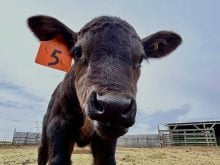Spring is a good time to review your cow herd’s mineral-vitamin program, as nursing cows (and bulls) should be in good mineral and vitamin status that drive a solid return to active reproduction by the breeding season.
In order to do so, beef producers often collect and review several commercial feed labels. Most list the guaranteed analysis of macro-, micro- and fat-soluble vitamins found in each product. Regardless of many choices, it’s a good idea to buy a good “min-vit” feeding program that helps gets your cow herd bred and into calf.
In the last few weeks of this calving season, I have walked along the fence of several drylots and holding pastures to assess the general body condition of beef cows. Although dietary energy and protein have a lot to due with maintaining or achieving such good condition and general good health, meeting essential mineral and vitamin requirements is equally important.
Read Also

Harvest wraps up and fall work begins
At the Eppich famly ranch in western Saskatchewan, the fall harvest was successful with few breakdowns, cows and calves have been sorted and a new tractor has arrived
My first wish is that all beef cows calve out in a body condition (BCS) of five to six, which should be carried to the end of the upcoming breeding season. Adequate BCS has been research-proven to return a higher proportion of fertile beef cows compared to thin cows (BCS < 4.0) to a strong estrus 80-90 days post-partum, which ends in high conception rates.
Here’s my strategy
After each assessment, I am ready to put together a good mineral-vitamin feeding program that will match most cows’ macro- and trace-mineral and vitamin requirements. In doing so, I follow a three-point goal-oriented strategy:
- Complement the cows’ forages for calcium and phosphorus. A feed test may be very useful, but if I don’t have one, I find out the kind of hay, silage or later, the pasture, on which post-calving cows are fed. For example, I know a 120-cow beef producer that corn-grazes his cow herd until they calve. Then he feeds them corn silage-based diet until pastures are well established. Since corn-based forages are very low in calcium, a 21:7 or 3:1 calcium-to-phosphorus ratio is my recommendation. Likewise, when producers are feeding bales of calcium-enriched alfalfa/mixed grass hay to their cattle, a 10:10 ratio makes a better fit.
- Assess regional soil/forage and water mineral levels. Western Canada’s forages and pasture are notorious for deficient levels of essential trace minerals, or contain antagonistic elements that bind essential trace minerals and render them biologically unavailable to cattle. For example, a beef cow requires about 100 mg of copper per day, and her forages contain this adequate amount. Yet a high molybdenum level in this forage or high sulphates in well water can bind dietary copper and render it unavailable to the cow. In these cases, I often increase the dietary concentration of copper in the mineral feeding program, or switch to a cattle mineral formulated with “chelated” copper (a more bioavailable form).
- Review the mineral directions for use. Many producers will compare a min-vit feed label’s guaranteed analysis that illustrates its concentration of minerals and vitamins, but fail to note its feeding level. The feeding rate of loose mineral or mixed into the beef cows’ diet is between 100 and 300 grams per head daily. Such variance dictates the absolute amount of each mineral and vitamin that the cow eats, and its overall cost of feeding.
For example, Mineral A costs $52 per 25-kg bag, its feeding rate is 100 grams per head, and contains 3000 ppm of copper. Put that against a bag of cattle Mineral B that costs $62 per 25-kg bag, but its feeding rate is 50 grams per head, plus contains 6000 ppm. As a result, mineral A and B supply about the same amount of copper , but the cost to feed mineral A is 20.8 cents per head/day compared to 12.4 cents per head/day, respectively. Keep in mind tha feeding mineral B might be cheaper, but there might be other extenuating features of each mineral that determines its final value.
It’s fortunate that most people recognize the importance of a good mineral-vitamin program for their fresh cow herd leading up to the breeding season. Many use a similar strategy that I use to buy one that works for them. In this way, spending about $20 for vit-min per post-partum cow (80 -90 days) that contributes to a saleable fall-calf that brings about $1,400 in today’s market is a good investment.
















